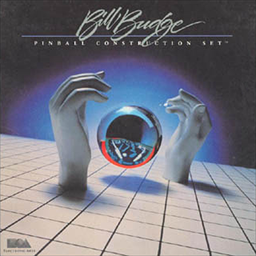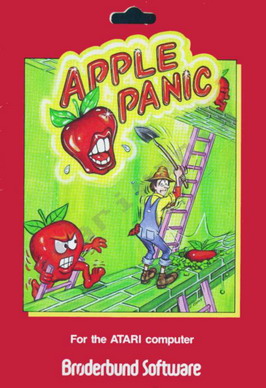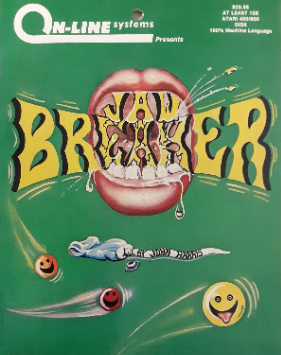
Zaxxon is a scrolling shooter developed and released by Sega as an arcade video game in 1982. The player pilots a ship through heavily defended space fortresses. Japanese electronics company Ikegami Tsushinki was also involved in the game's development.

Pinball Construction Set is a video game by Bill Budge written for the Apple II. It was originally published in 1982 through Budge's own company, BudgeCo, then was released by Electronic Arts in 1983 along with ports to the Atari 8-bit computers and Commodore 64.

Centipede is a 1981 fixed shooter arcade video game developed and published by Atari, Inc. Designed by Dona Bailey and Ed Logg, it was one of the most commercially successful games from the golden age of arcade video games and one of the first with a significant female player base. The primary objective is to shoot all the segments of a centipede that winds down the playing field. An arcade sequel, Millipede, followed in 1982.

Lode Runner is a 2D puzzle-platform game, developed by Doug Smith and published by Broderbund in 1983. Its gameplay mechanics are similar to Space Panic from 1980. The player controls a character who must collect all the gold pieces in a level and get to the end while being chased by a number of enemies. It is one of the first games to include a level editor.
1982 was the peak year for the golden age of arcade video games as well as the second generation of video game consoles. Many games were released that would spawn franchises, or at least sequels, including Dig Dug, Pole Position, Mr. Do!, Zaxxon, Q*bert, Time Pilot and Pitfall! The year's highest-grossing video game was Namco's arcade game Pac-Man, for the third year in a row, while the year's best-selling home system was the Atari 2600. Additional video game consoles added to a crowded market, notably the ColecoVision and Atari 5200. Troubles at Atari late in the year triggered the video game crash of 1983.

David's Midnight Magic is a pinball simulation video game written by David Snider for the Apple II and published by Broderbund in 1982. The game was published in Europe by Ariolasoft. A port to Atari 8-bit computers was released the same year, then the Commodore 64 in 1983. In 1987 Atari Corporation published a cartridge version in the styling of the then-new Atari XEGS.

Shamus is a shooter with light action-adventure game elements written by Cathryn Mataga and published by Synapse Software. The original Atari 8-bit computer version was released on disk and tape in 1982. According to Synapse co-founder Ihor Wolosenko, Shamus made the company famous by giving it a reputation for quality. "Funeral March of a Marionette", the theme song from Alfred Hitchcock Presents, plays on the title screen.

Apple Panic is a game for the Apple II programmed by Ben Serki and published by Broderbund Software in 1981. Apple Panic is an unauthorized version of the 1980 arcade game Space Panic, the first game with ladders and platforms. While the arcade original remained obscure, Apple Panic became a top seller for home computers. It was ported to the Atari 8-bit computers, VIC-20, IBM PC, and TRS-80.

Drol is a video game published by Broderbund in 1983. It was written for the Apple II by Benny Aik Beng Ngo, then ported to the Commodore 64 and Atari 8-bit computers. Versions were released for the SG-1000 in 1985 and Amiga in 1991.
Synapse Software Corporation was an American software developer and publisher founded in 1981 by Ihor Wolosenko and Ken Grant. Synapse published application software and developer tools and was primarily known for video games. It initially focused on the Atari 8-bit computers, then later developed for the Commodore 64 and other systems. Synapse was purchased by Broderbund in late 1984 and the Synapse label retired in 1985.

Crossfire is a multidirectional shooter created by Jay Sullivan for the Apple II and published by On-Line Systems in 1981. Using keyboard-based twin-stick shooter controls, the player maneuvers a ship in a grid-like maze. Versions with joystick-control use the stick for movement and switch to firing mode when the button is held down.
Dan Gorlin is a video game programmer and designer best known for his 1982 Apple II game Choplifter, in which the player pilots a helicopter to rescue hostages. His next Apple II game, Airheart (1987), took three years to complete. While technically advanced, it was not as well received as Choplifter. He wrote the sequel to Airheart for the Atari ST: Typhoon Thompson in Search for the Sea Child (1988). All three games were published by Broderbund.

Fort Apocalypse is a multidirectional scrolling shooter for Atari 8-bit computers created by Steve Hales and published by Synapse Software in 1982. Joe Vierra ported it to the Commodore 64 the same year. The player navigates an underground prison in a helicopter, destroying or avoiding enemies and rescuing prisoners. A contemporary of Choplifter, it has similarities to that game as well as the arcade games Scramble and Super Cobra.

Jawbreaker is a Pac-Man clone programmed by John Harris for Atari 8-bit computers and published by On-Line Systems. Released in 1981 before an official version of Pac-Man was available, it was widely lauded by reviewers and became a major seller. The story of its creation and Harris's Atari 8-bit implementation of Frogger form a portion of Steven Levy's 1984 book, Hackers: Heroes of the Computer Revolution.

Serpentine is a maze video game written by David Snider for the Apple II and published by Broderbund in 1982. Serpentine's gameplay and visuals are similar to the Konami arcade game, Jungler, released the previous year. It was ported to the Commodore 64 and Atari 8-bit computers. A VIC-20 version was licensed to Creative Software.

Karateka is a 1984 martial arts action game for the Apple II by Jordan Mechner. It is his first published game and was created while he was attending Yale University. The game was published in North America by Broderbund and in Europe by Ariolasoft. Along with Karate Champ and Yie-Ar Kung Fu, Karateka is one of the earliest martial arts fighting games. It was inspired by Japanese culture and by early Disney animated films and silent pictures. An influential game of its era, it was one of the first to use cinematic storytelling and sound design, and rotoscoped animation.

Choplifter HD is a video game developed by inXile Entertainment and released in 2012-2013. It is a 3D polygonal remake of the 1982 game Choplifter by Dan Gorlin. inXile hired Gorlin to serve as a design consultant for the game. As in the original game, players fly missions in a helicopter, defeating enemies and rescuing people. Originally released for Windows, Xbox 360 and PlayStation 3, the game was subsequently ported to the Ouya as well as Android devices. Choplifter HD was lauded for being true to the original, retaining the gameplay the series was known for, but was criticized for its high level of difficulty.

Night Mission Pinball is a pinball simulation video game published by Sublogic in 1982. It was developed by Bruce Artwick for the Apple II, then ported to the Atari 8-bit computers, Commodore 64, and IBM PC.

A.E. is a fixed shooter written by Jun Wada and Makoto Horai for the Apple II and Atari 8-bit computers and published by Broderbund in 1982. Versions followed for the VIC-20 (1983) and MSX (1984). Unlike most earlier shooters which have a solid color or starfield as a background, the action in A.E. takes place in front of science fiction scenes. Attacking creatures emerge from points in the image, often appearing to come from behind objects. Combined with a slight scaling as they advance, there is the impression of depth.
















